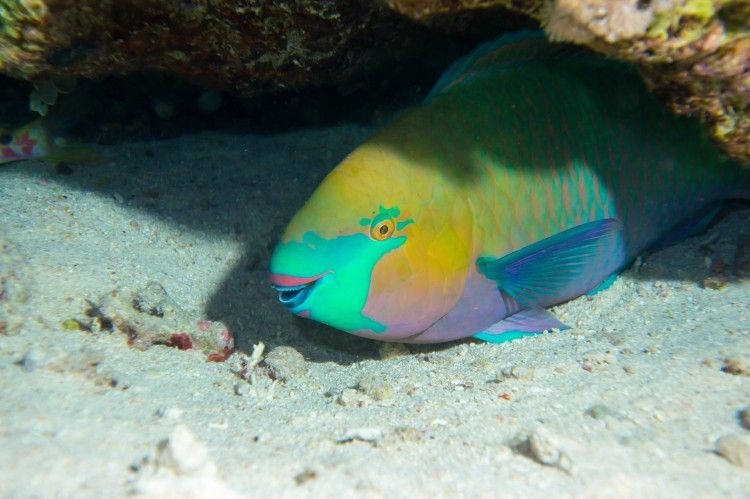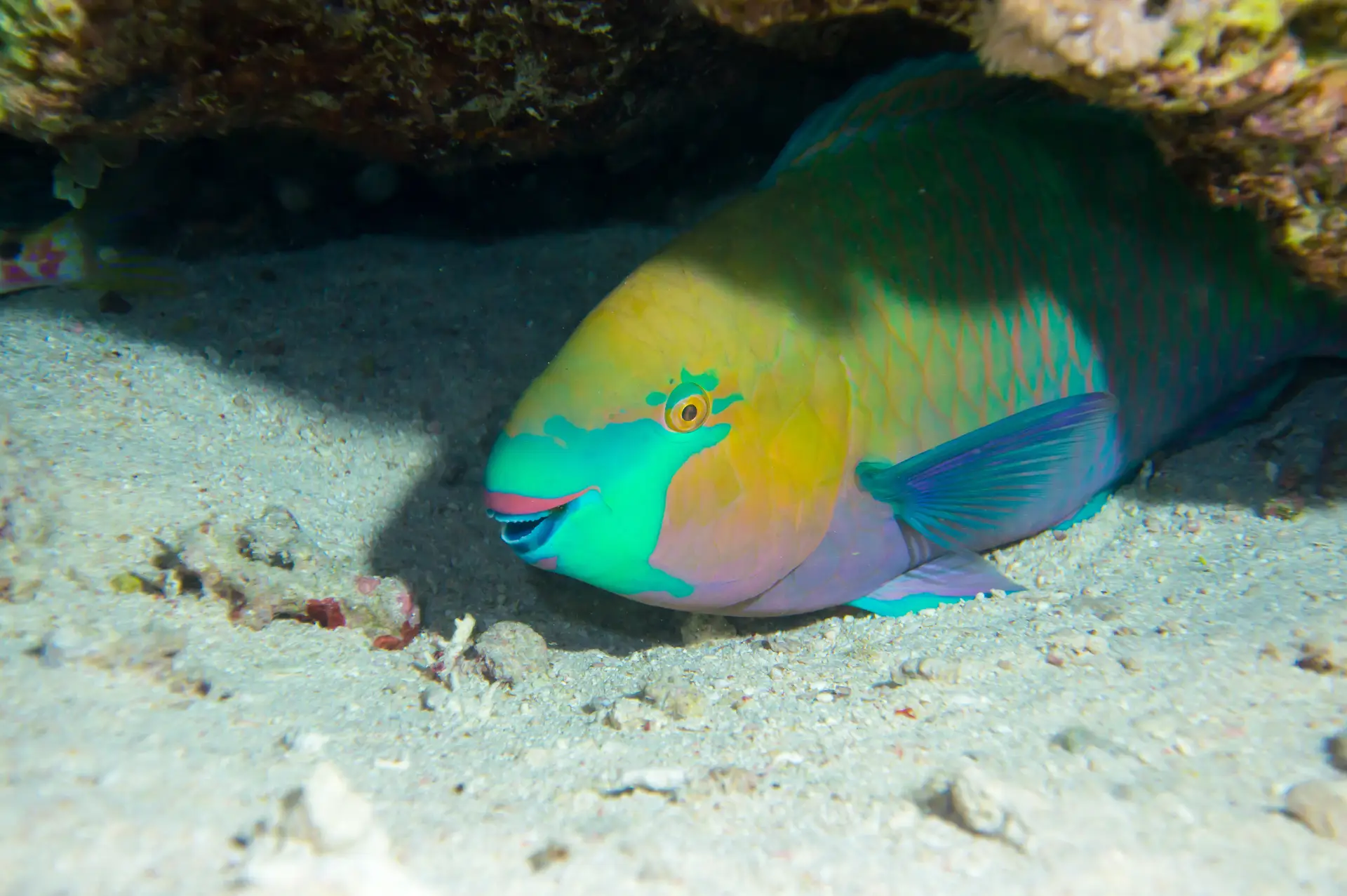
The Vibrant World of Parrotfish in Boracay, Philippines
The Vibrant World of Parrotfish in Boracay, Philippines
Introduction to Parrotfish
Imagine gliding through the crystal-clear waters of Boracay, surrounded by a kaleidoscope of colors and bustling marine life. While scuba diving in Boracay among the many fascinating creatures you’ll encounter, parrotfish stand out with their vibrant hues and unique beak-like mouths. These incredible fish are not only a visual delight but also play a crucial role in maintaining the health of coral reefs. In this article, we’ll dive deep into the world of parrotfish, exploring their characteristics, behaviors, and the vital ecological roles they fulfill in Boracay’s rich marine ecosystem.
Understanding Parrotfish
Physical Characteristics
Parrotfish are easily recognizable by their vivid colors and distinctive beak-like mouths. These beaks are actually fused teeth that allow them to scrape algae from coral and rocky surfaces. Parrotfish can vary greatly in size, with some species growing up to 1.2 meters in length. Their vibrant scales can display a range of colors, including blue, green, pink, and yellow, making them one of the most visually striking fish in the reef.
Unique Features
One of the most intriguing features of parrotfish is their ability to change sex. Many species are hermaphroditic, meaning they can change from female to male at some point in their lives. This ability ensures the continuation of their species even when the population dynamics change. Additionally, parrotfish are known for their ability to produce a mucus cocoon at night, which acts as a protective barrier against predators and parasites.
The Role of Parrotfish in the Ecosystem
Coral Reef Maintenance
Parrotfish play a crucial role in the health and maintenance of coral reefs. By grazing on algae, they prevent the overgrowth that can smother and kill corals. This grazing behavior helps to maintain a balance in the reef ecosystem, allowing corals to thrive and support a diverse range of marine life. Their beak-like mouths are perfectly adapted for scraping algae off hard surfaces, a process that also helps to create sand.
Sand Production
Believe it or not, much of the white sandy beaches we enjoy can be attributed to parrotfish. As they feed on algae and coral, they excrete fine sand, contributing significantly to the sandy environments found in tropical regions like Boracay. A single parrotfish can produce hundreds of kilograms of sand each year, making them essential to the formation and maintenance of these beautiful beaches.
Parrotfish Behavior
Feeding Habits
Parrotfish are primarily herbivores, feeding on algae that grow on coral and rocks. This feeding activity occurs throughout the day, with the fish often seen nibbling away at the reef. Their powerful jaws and beak-like teeth enable them to bite off chunks of coral, which are then ground down in their pharyngeal teeth to extract the algae. This unique feeding process not only helps control algae growth but also aids in the creation of new habitats within the reef.
Social Structure and Reproduction
Parrotfish exhibit fascinating social structures and reproductive behaviors. They often form harems, consisting of one dominant male and several females. The dominant male is typically the most brightly colored, a trait known as sexual dichromatism. In the event of the dominant male’s death, the largest female in the harem can transform into a male, ensuring the continuity of the group.
Species of Parrotfish in Boracay
Boracay’s rich marine biodiversity means divers can encounter several species of parrotfish. Some of the most common species include:
- Stoplight Parrotfish (Sparisoma viride): Known for its changing colors and distinct phases, ranging from red and green to a bright, stoplight-like appearance.
- Princess Parrotfish (Scarus taeniopterus): Characterized by its brilliant blue and green hues, with striking yellow accents.
- Queen Parrotfish (Scarus vetula): Notable for its large size and vibrant blue and green colors, often with a pinkish hue on the head.
Diving with Parrotfish in Boracay
Dive Sites
New Wave Divers offers access to some of the best dive sites in Boracay where you can encounter parrotfish. Notable spots include Crocodile Island, Friday’s Rock, and Balinghai, each offering a unique underwater landscape and abundant marine life. These sites provide excellent opportunities to observe parrotfish in their natural habitat, grazing on algae and interacting with other reef inhabitants.
Best Practices for Divers
While diving with parrotfish, it’s important to follow best practices to ensure their protection and the preservation of the reef ecosystem. Here are some tips for responsible diving:
- Maintain Buoyancy: Avoid touching or standing on the coral to prevent damage.
- Respect Wildlife: Observe parrotfish from a distance without disturbing their natural behavior.
- Eco-Friendly Products: Use reef-safe sunscreen and avoid using plastic products that can harm marine life.
Conservation Efforts
New Wave Divers is committed to marine conservation and sustainable diving practices. They actively participate in reef clean-ups, coral restoration projects, and educational programs aimed at raising awareness about the importance of protecting Boracay’s marine environment. By choosing to dive with New Wave Divers, you contribute to these conservation efforts and help preserve the vibrant underwater world for future generations.
Conclusion
Parrotfish are not only one of the most colorful and captivating fish you’ll encounter in Boracay’s waters, but they also play a vital role in maintaining the health and beauty of coral reefs. Their unique feeding habits, social structures, and contributions to sand production make them indispensable to the marine ecosystem. By diving with New Wave Divers, you’ll have the opportunity to witness these incredible creatures up close and learn about the importance of marine conservation.
So, gear up and dive into the mesmerizing world of parrotfish with New Wave Divers. Experience the vibrant underwater paradise of Boracay and create unforgettable memories while contributing to the preservation of this precious marine environment.
diving philippines, marine life of boracay, parrotfish, scuba diving boracay
